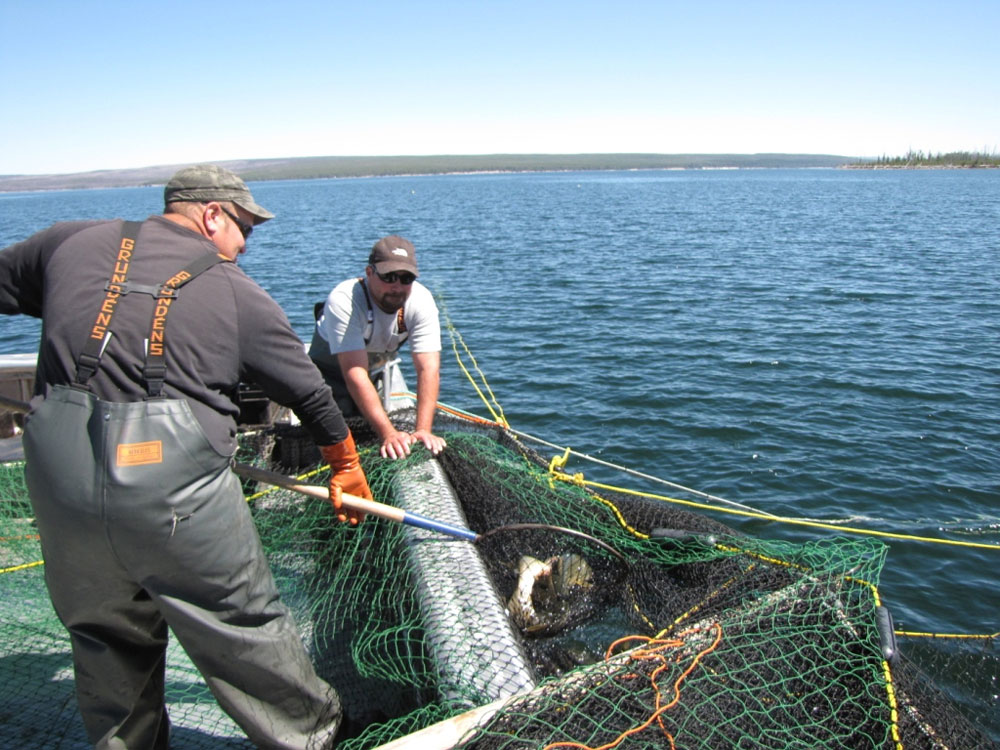
The Hickey Brothers, fishing contractors for the National Park Service, use trapnets to try and reel in lake trout. The species has been growing in Yellowstone lakes at an exponential rate and overfeeding on the Yellowstone cutthroat, threatening the park’s entire ecosystem. (Dan Hottle/NPS — click to enlarge)
By Kelsey Dayton/WyoFile.com
The fall foliage in Yellowstone National Park is changing. Bright yellows mark aspen trees and burnt oranges transform brush. Visitors crane from cars in early morning light, straining to glimpse a bear or wolf.
The shores of Yellowstone Lake are quiet compared to the days of July and August. The water is almost deserted.
But the few boats out are waging a never-ending battle with underwater invaders threatening not just the aquatic hierarchy of the lake, but the grizzly bears, bald eagles and entire park ecosystem.
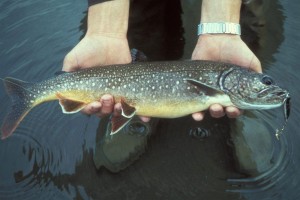
The lake trout have plagued Yellowstone Lake since their presence was made known in 1994. A single female can lay thousands of eggs and live up to 50 years, making them a particularly resilient foe. (Courtesy of U.S. Fish and Wildlife Service — click to enlarge)
If ever a fish deserved the moniker “Monster of the Deep,” it would be the lake trout.
It grows to an average length of 18-23 inches and can live for 50 years. Last year, nets on Yellowstone Lake caught three weighing more than 28 pounds. Every fall it lays thousands of eggs to propagate the population at an exponential rate.
Slice one through its silver scales and open the belly, and you might find the most frightening thing of all: the remains of several Yellowstone cutthroat. Lake trout eat about 50 cutthroat per year and are decimating the population, causing potential repercussions felt park-wide.
The lake trout’s annihilation of Yellowstone cutthroat trout has become one of the park’s greatest conservation priorities, said David Hallac, chief of Yellowstone Center for Resources, a National Park Service clearinghouse for science and resource management information.
The disappearance of cutthroat trout in the park impacts more than 40 bird and mammal species and the overall health of the ecosystem.
Attempts to save Yellowstone cutthroat began when they were first discovered in Yellowstone Lake in 1994. Work reached a crescendo this year with organizations helping fund work and research on Yellowstone Lake, where lake trout have particularly overwhelmed the world’s largest natural cutthroat population. A combination of sci-fi like technology and experiments coupled with good old fashioned fishing could help shrink the lake trout population and in turn allow the cutthroat to thrive.
Cutthroat stronghold
Sitting at 7,733-feet and covering about 139 square miles with 110 miles of shoreline, Yellowstone Lake is the largest high-elevation lake in North America. It also is home to the largest concentration of genetically pure cutthroat, said Todd Koel, supervisory fisheries biologist with Yellowstone National Park.
The golden fish, identified by the red slash under their jaw, have called Yellowstone home since the end of glaciation, or about 10,000 years, Koel said.
Each spring, the fish make their way out of the lake and up picturesque mountain streams to spawn, where they fall prey to animals like grizzly bears.
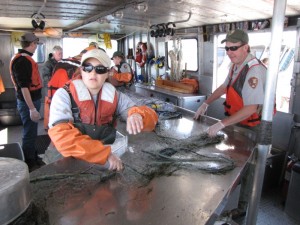
NPS personnel perform gillnetting on captured lake trout. Such coordinated efforts are key to suppressing the lake trout population. (Dan Hottle/NPS — click to enlarge)
The first lake trout were discovered in Yellowstone Lake in 1994, Koel said.
Today, the park works to prevent introduction of non-native species, inspecting boats and trailers for even the smallest of passengers or hitchhikers such as zebra mussels.
“The best way to eradicate a species is not allow introduction of them,” Koel said.
While it seems like common sense, the potential impact of non-native species wasn’t always considered. Decades ago, introducing new species, especially by stocking lakes with desirable non-native fish, was common practice, Koel said.
Lake trout were introduced into the area in 1890 when someone stocked Lewis Lake, Koel said. Located near the south entrance of the park, the lake was fish-less at the time.
It is likely someone took fish caught in Lewis Lake and released them in Yellowstone Lake in the 1980s, Koel said. Genetic work shows the Yellowstone Lake lake trout are related to those found in Lewis Lake.
The lake trout thrived in Yellowstone Lake. In the Eastern United States, scientists are working on restoring lake trout. On Sept. 19, as workers hauled in dozens of lake trout from Yellowstone Lake for slaughter, a visiting biologist tried to glean what made them so successful in Yellowstone and how that could be replicated in their native waters.
Since arriving in Yellowstone Lake, lake trout have significantly reduced the cutthroat population, not only competing with the fish for native invertebrates for food, but also eating the cutthroat.
At Clear Creek, a peak of 70,000 cutthroat were counted making their way to spawn in the stream in 1978. In 2008, less than 500 were counted. The monitoring station was washed away during a season of high water, but is expected to be restored next year.
In Bridge Creek there were 2,363 cutthroat in 1999. In 2004, only one was found.
“It’s a staggering decline,” Koel said.
Cutthroat throughout the park have declined, related to non-native fish introductions. In many places cutthroat mate with rainbow trout creating a hybrid species, called by some fishermen cutbows.
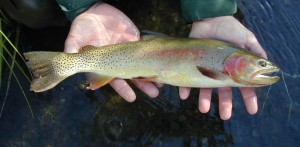
Unlike the lake trout, the Yellowstone cutthroat has to leave Yellowstone Lake to reproduce. (Courtesy of U.S. Department of Agriculture — click to enlarge)
While hybridization causes its own set of conservation issues, the park has to prioritize efforts, Hallac said. And nothing is more pressing than the decimated population in Yellowstone Lake.
“It’s not just about the fish or the fishermen,” he said. “It’s about the entire ecosystem.”
Unlike cutthroat, lake trout don’t leave the lake to spawn. Instead, they spawn in the fall in shallower waters, so they don’t replace cutthroats in streams as a food source to animals that depend on the yearly fish migration.
Lake trout also live most of the year much deeper in the water, 60 feet or more below the surface, Koel said. Some have been caught in nets set 160 feet or deeper. That means birds, like eagles and osprey that feed on cutthroat don’t have a replacement food source.
Blood and guts
The deck of the Northwester, a small fishing boat on Yellowstone Lake, was slick with water and slime and despite the breeze and scent of exhaust from the boat, it reeked with unmistakable scent of fish.
Jake Junio and Andy Stuth of Hickey Brothers Fisheries, a commercial fishing company from Wisconsin, hauled in only two fish at one site from the large trap.
The lake trout program on Yellowstone Lake is one of the biggest suppression efforts in the country — perhaps only work on the Great Lakes to decrease lamprey is larger, Koel said.
The Yellowstone suppression efforts rely on gill-netting and trapping the fish.
The large live traps allow fishermen like Junio and Stuth to trap lake trout in shallower water where cutthroat also live. Stuth quickly slit each lake trout hauled in from the trap, opened it to determine the sex and also to allow it to sink to the bottom once tossed back overboard. Hundreds of tiny orange eggs spilled out as he recorded the length, before flipping it carelessly over the side of the boat.
The Northwester moved to the next trap site — there are 10 set in the lake all summer. The traps are boxes up to 40 feet high with wings that expand 1,000 feet in each direction to guide fish into the trap. Trap nets also manage to kill male lake trout that are drawn to the net by the females caught inside, and often catch their gills on the outside of the trap.
Machines on the boat rumbled and whirred as the traps were drawn in; transforming the boat deck into a crisscross of rope reminiscent of a child’s string came that overtook the surface. As the nets came in, some fish could be seen thrashing, attached to the traps. Those hooked to the sides of the trap were squeezed off and tossed into buckets. The real haul was in the center of the trap.
Junio used a net to scoop the squirming fish, shoveling them into tubs. The fish thrashed, struggling to breathe in the air, fighting so hard to make their way back to water some popped out of the bins, tails whipping on the deck in a last-ditch effort to live. Water and blood and slime splashed with each scoop plopped in the bins. In the masses of the green and silver fish, a cutthroat is easy to spot. Junio and Stuth are gentler when holding a cutthroat, removing it from the squirming masses and setting it free in the water. In that one haul they estimated 150 to 200 lake trout.
The dead lake trout are tossed back into the water to provide nutrients, but also because it’s the easiest way to deal with dead fish, Hallac said. Processing the fish for sale would take too long. And allowing commercial fishing, or creating a financial incentive to fish could hurt conservation efforts, he said. If people or agencies make money off invasive species, there is less desire for people to want to eradicate it.
Elsewhere on the lake, the crew of the Freedom hauled in gillnets, the other major method of killing lake trout.
The Freedom was sparsely decorated. Rusting beer cans — PBR, Coors and Fat Tire — sat in the eves. A long table took up the bulk of the space. When the nets are hauled in the crew each picked a spot and began unwrapping the fish.
Some fish were wound so tightly in the fine netting they looked as though they’d been cocooned. Some were still alive, fighting even as they were slit open, their stomach contents under examination.
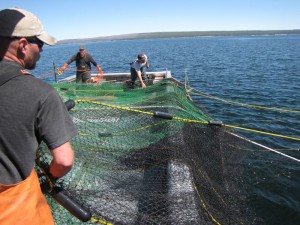
The Hickey Brothers, working a contractor boat for the National Park Service, set their trapping net for lake trout on Yellowstone Lake. The trapping efforts have been taking place since 2010. (Dan Hottle/NPS — click to enlarge)
Gillnets are set in “gangs” with many net panels tied together, running about 1,800 feet long, or a third of a mile, Koel said. The gillnet gangs the contractors use are longer. There 30 to 40 gangs in the lake at any time, Koel said.
Occasionally, the nets bring in a cutthroat trout. Of those caught in the nets, about 50 percent survive, said Pat Bigelow, fisheries biologist with the park service. The live ones are released. The park’s data shows that about two cutthroat die for every 100 lake trout killed, Hallac said.
As of Sept. 18, 274,042 lake trout had been captured in Yellowstone Lake this year. The goal is to reach 300,000 before operations end in October, Koel said.
Netting and trapping began on the lake in 2010 with two boats. This year, there are four, including two owned by the Hickey Brothers.
The lake trout population in Yellowstone Lake was estimated at about 500,000 adult fish this year.
Total eradication of lake trout is impossible, Koel said.
The goal instead is to suppress the population to a much lower number and maintain it at that level.
It is believed if 50 percent of the lake trout population can be removed each year for six consecutive years, the population can be managed at a much lower cost, said Ken Barrett, native fish campaign manager with the Yellowstone Park Foundation.
In March, the foundation gave Yellowstone $1 million for lake trout suppression work, which allowed the park to hire the Hickey Brothers.
The efforts cost about $2 million a year, Hallac said.
As the population declines, netting and trapping is going to become less economically efficient and sustainable, said Bob Gresswell with the USGS.
Gresswell has been studying the movement of lake trout, thanks to almost 200 “Judas fish.” In 2011, more than 100 lake trout, known as “Judas fish,” were tagged with transmitters and will hopefully lead researchers to spawning areas to kill the eggs and young of the fish. Tracking the fish’s movements will also make netting and trapping more efficient.
Each tag costs about $400, depth recording transmitters cost $700 and receivers cost $1,400, and were paid for by group such as the Greater Yellowstone Coalition, National Parks Conservation Association and Trout Unlimited, said Scott Christy, Wyoming coordinator with Trout Unlimited . They are tagged with an orange wire on the outside that alerts fishermen. Inside is a small transmitter. The tags are placed by “surgeons,” those trained to open the fish up and insert the transmitters.
Lake trout are swarm spawners, Christy said. That means they gather in only one of a few spots and spawn together.
“This is our chance,” Christy said. “This is something we can make manageable. If we can find these spawning beds, I think we can do this without having to raise money for it every year. Can we ever win this issue? Probably not. But we can make it manageable.”
Already, researchers have identified one spawning area.
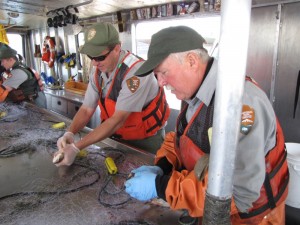
National Park Service personnel cut open lake trout to inspect for eaten cutthroat. Such efforts might be made easier with the location and destruction of lake trout spawning areas. (Dan Hottle/NPS — click to enlarge)
Carrington Island is so small it’s a wonder it garnered a name. A small pile of rocks near West Thumb with a single pine tree marks a spot where it’s believed about 50 percent of the lake trout population spawn in the shallow waters in the fall. While lake trout usually spawn in shallower waters between five and 25 feet deep, they have been known to lay eggs up to 100 feet deep in lakes in Montana and Idaho, which makes it difficult for predators and researchers to reach or find the eggs, Gresswell said. It also makes finding spawning spots challenging.
There are likely no more than 12 spawning areas in the lake, he said.
Once the spawning areas are found, it is hoped tactics can be used to kill the eggs.
Research on possible methods will be conducted next year at Carrington Island. Possible methods include using electricity to kill the eggs, carbon dioxide to suffocate newly hatched lake trout, “sonic guns” that create sound waves that shatter the eggs or a giant vacuum to suck up the eggs, Christy said.
There are still a lot of unknowns, such as if where the eggs are laid is accessible to the different methods, but having a variety of methods to try is promising.
Gresswell sees egg extermination as a supplement to the netting and trapping efforts that will help decrease costs while still keeping the lake trout population in check. Efforts to restore the cutthroat rely on organizations that provide interns or students to help, as well as park volunteers — people, like Leo Romanouski, who willingly offer their summers to work with dead fish.
Romanouski’s daughter, Brook, caught her first fish, a cutthroat, in Yellowstone when she was four years old. Her father cooked it for dinner that night. That was 31 years ago, Leo Romanouski said.
Romanouski and his daughter returned to Yellowstone nine years ago when she took a seasonal job and Romanouski decided when he retired he’d come volunteer and spend a summer in the park.
The petroleum engineer left his job and Georgia this summer to live in a camper and spend a week at a time working on the gillnetting boats.
“This used to be the greatest place to fish for cutthroats,” he said.
Perhaps one day it will be again.
Republished with permission from WyoFile.com. Kelsey Dayton is a freelance writer based in Lander. She has been a journalist in Wyoming for seven years, reporting for the Jackson Hole News & Guide, Casper Star-Tribune and the Gillette News-Record. Contact Kelsey at kelsey.dayton@gmail.com.

Who besides me remembers when the NPS ran a fish hatchery at the Lake Hotel area before the Bridge Bay Marina was built, and among other things created a new Cutthroat trout hybrid, the Golden ? A Frankenfish… part Yellowstone Cutt, part Golden trout ( a high altitude lake trout native to California’s Sierra Nevadas and occasionally stocked in Wyoming subalpine lakes . It is possibly a subspecie of the Rainbow, and also a salmonid ) and maybe hybridized with other trout species as well.) The last living Yellowstone Goldens were in a decorative stone pool inside the Billings MT Airport terminal c. 1960’s
So , yes…Yellowstoners were messing with native fish genetically up there for some time. Playing God. Some say it is well known in certain circles who among the Park Service ranger staff actually stocked Yellowstone Lake with the Mackinaw lakers from the other side of the Divide at Lewis Lake, long before 1980, maybe as far back as 1960. While it was intentional it was not smart. Some of those folks are still alive, so expect the secret to be kept a while longer.
The sidebar to this story is the Wyoming Game and Fish Department’s cooperative program to restock Absaroka high country watersheds outside Yellowstone with Yellowstone Cutts, to provide a hedge population. They kill all the fish in a suitable stream with Rotenone across two runoff seasons, then start over with Cutts. So far, so good. Neither Doctor Frankenstein nor God have objected , to date.
Why not just introduce the Lamprey Eel to Yellowstone Lake? This Eel killed Lake Trout by the millions in the Great Lakes between 1940 and 1960. Once the Lakers are eliminated, and the Eels starved to death, the native Cutthroat Trout could be restocked. It may take 10-15 years, but seems much wiser than the current fishery effort which will NEVER eliminate the threat of Lakers.